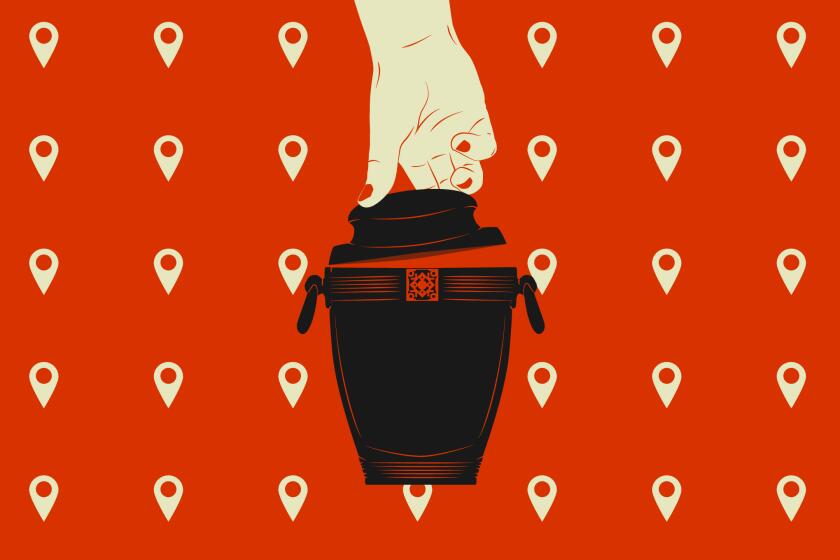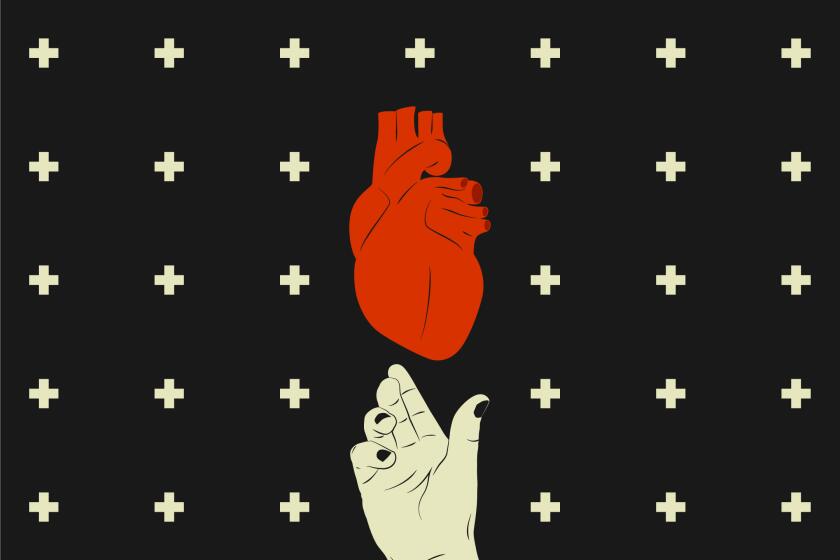
When a person dies, many people may think of the two most common options for the deceased person’s body: burial or cremation.
But for people who want to do something eco-friendly, such as human composting, or unique, like blasting their remains into orbit, more options are becoming available and legal.
And more common: The National Funeral Directors Assn. found in 2021 that 60.5% of its respondents said they’re interested in exploring green funeral options because of their potential environmental benefits. A typical cremation can take 30 minutes to two hours, emitting carbon dioxide into the air the whole time. Traditional burial has its own environmental impacts, including contaminating soil with the chemicals used on the body (formaldehyde and other preservatives).
In California, the median cost of an adult funeral that includes a viewing, ceremony and burial is $7,225, according to the NFDA. The median cost for cremation services is $6,028.
Here’s a rundown of several nontraditional, green or unique options. (Note that some religions — including Catholicism, Islam and Judaism — restrict what can be done with bodies after death. If that’s a consideration of yours, check with your faith leader before making your final arrangements.)
Talking about burial arrangements or end-of-life care isn’t the easiest conversation to have with family members. But it can be done with respect, humility and love.
Human composting
An alternative to traditional burial and cremation coming to California in 2027 is natural organic reduction, otherwise known as human composting. (Last year Gov. Gavin Newsom signed Assembly Bill 351 into law, giving the state’s Cemetery and Funeral Bureau the green light to develop regulations for facilities offering the service.) Natural organic reduction is already legal in Washington, Colorado, Oregon and Vermont.
Human composting involves remains naturally decomposing over a 30- to 45-day period after the body is placed in a steel vessel and covered with biodegradable materials.
What do you do when someone dies?
Because we find death so hard to talk about, there are probably lots of things people wonder but don’t know. We have answers.
Recompose, which offers natural organic reduction in the state of Washington, said through its process it uses 87% less energy than traditional burial or cremation — you’ll save one metric ton of carbon from entering the environment, which is equivalent to the CO2 emissions of driving 2,421 miles.
It offers its services for $7,000. The cost includes taking the body to its facilities, transforming the body into soil, legal funeral documents, an online obituary and support from the company’s services team.
Cremation by water
Alkaline hydrolysis, also known as water cremation, is a natural method of decomposition that uses water to cremate the body.
This process uses water, alkaline chemicals, heat and sometimes pressure and agitation to accelerate natural decomposition, according to the Cremation Assn. of North America. The end result is bone fragments and a liquid called effluent. Effluent is sterile, meaning no DNA or tissue remains, and the liquid can be released down a drain.
California legalized water cremation in 2017, but it became more widely known when Desmond Tutu, the anti-apartheid leader and South African Anglican archbishop emeritus who died in December 2021, requested it.
Several funeral homes in Los Angeles County offer the service, including Commerce-based Pisces. Christopher Taktak, Pisces’ chief executive, said a solution that is mostly warm water takes about four hours to leave behind bone material that people will inter or take home.
Taktak said his company’s process doesn’t release harmful emissions and uses 90% less energy than flame cremation.
Pisces’ services cost $3,850. That includes pickup and transport of the body, the water cremation, mailed return of ashes or scattering the ashes at sea and a handmade Pisces urn.
L.A. is a complicated place to live. Does it have to be such a complicated place to scatter ashes after someone dies?
Tree burial
Reducing your carbon footprint beyond your time on Earth could mean planting a tree with your remains. Across the state, funeral homes and cemeteries offer memorial trees where cremains are mixed with soil used to grow a tree on the cemetery grounds.
You can be a permanent part of a tree’s life in Los Angeles’ Hollywood Forever’s Ancestral Forest Project. Hollywood Forever allows cremains to be planted with the roots of a new tree or adjacent to an existing tree of your choice. With its Heritage Program, you may have your cremated remains placed in a space adjacent to an existing mature tree (cypress sentinels, California fan palms, redwoods and olive trees) starting at $6,600 — a portion of your fund will be placed into an endowment trust to ensure long-term care and maintenance of your living memorial.
Through the Memorial Tree program, a newly planted memorial tree can accommodate two sets of cremated remains for $13,750.
If you’re looking for a family option, the Family Tree program accommodates the placement of six sets of cremated remains starting at $27,500.
In 52 acres of the cemetery’s ancestral forest, you can choose to be planted with live oak, cypress, jacaranda, canary pine, palm or ginkgo trees.
There is also a San Francisco company working to create conservation forests where you can pay to use cremains to grow a memorial tree and also plant additional new saplings in areas that have been impacted by fires. Better Place Forests has protected forest lands in Lake Arrowhead, Point Arena, Santa Cruz and Yosemite Gateway, and is slated to have a space in the Western Sierra soon. The price depends on the estimated final size of the memorial tree trunk and how many additional saplings you want planted. For example, if you choose a 9-inch diameter trunk and 25 additional saplings it will cost $4,900 — the most economical package. The higher end of the packages includes a tree trunk that’s about 100 inches with an additional 500 saplings planted, costing $16,900. Friends and family of the deceased can visit the labeled memorial tree and enjoy the rest of the conserved forest.
When someone you care for dies unexpectedly, many responsibilities will fall onto your shoulders. Here’s a guide to what they are and how to handle them.
Space ‘burial’
Not all of us can become astronauts in this life, but your cremains can. Human ashes cannot be scattered in space, though; the remains must be in a container.
Celestis, a Texas-based company, first launched human ashes into space in 1997.
One option the company offers is the “Earth rise service,” which launches flight capsules containing cremated remains and DNA samples to outer space — about 62 miles above Earth — for $2,995. The cremains then return to Earth. The company’s priciest offering, with a starting cost of $12,995, is the “voyager service,” in which a portion of a person’s remains board a commercial spacecraft, headed to space for other purposes such as research, and the remains do not return.
Burial at sea
Honoring a surfer or an avid boater could mean scattering their ashes at sea. There’s also the option of a full-body burial or giving back to the ocean ecosystem by using cremains to make a reef ball.
Los Angeles Yacht Charter offers various sea vessels for scattering ashes at least three nautical miles off the coast. Prices for the service depend on the departure location and guest count: For example, a 50-foot yacht that holds 12 guests and departs from Marina Del Rey costs $795. A boat that departs from Long Beach and holds up to 125 guests is $1,295.
If you’re looking for a full-body burial service, Burial at Sea Southern California Coast offers its services across the state. The burials are done with biodegradable caskets that break down in the ocean within three to six months. The cost of this service depends on the number of people viewing the service and where the boat is departing from. For example, if the boat is departing from San Pedro with 12 guests on board, it’s estimated to be $775.
If you want your body to be a part of coral reef restoration, your family can use your cremains as part of a reef ball. According to the University of Miami, the Reef Ball Foundation was originally established in 1993 to promote coral reef restoration. Memorial service companies partner with the foundation to mix cremains with a specific concrete. What results is a hollow structure with holes, about 5 feet wide and 5 feet tall, that sits on the seafloor creating a marine habitat that supports fish and other sea life.
Ashes on the Sea in San Diego area offers the reef ball, also known as a living reef memorial. Its prices range from $600 to $4,000.
About half the U.S. population, including 18 million Californians, are registered organ donors. But whether you can actually donate organs depends on how you die, among other limiting factors.
Donating your body to science
Donating your whole body to science means you are playing a crucial role in a researcher’s work to improve their understanding of diseases, the development of treatment and human anatomy. If you decide to donate your body to a specific university in California, you’re also supporting the education of medical students.
University of California schools each have specific donation programs.
Any adult 18 years or older can register with a university’s program. Anyone can donate their body with the exception of people with Creutzfeldt-Jakob disease, hepatitis B or C, HIV and active tuberculosis.
Once the body is accepted and studied, the remains are cremated and scattered at sea.
An inheritance can be kept as separate property even in community property states. But keeping it secret is not the best way to cope with money-handling differences.
Memorialized in a diamond
Keeping a loved one close doesn’t have to be limited to an urn. Instead, their cremains can be turned into a family heirloom: a memorial diamond.
This type of diamond is artificially created with the carbon extracted from cremains.
Los Angeles-based Heart in Diamond turns cremation ashes or human or pet hair into a diamond.
The company’s process extracts carbon from cremated ashes by applying high pressure and high temperature. Then it places a tiny diamond “seed” and the pure carbon into a growth chamber to form the diamond. The rough diamond is then cut and polished to your specifications.
Heart in Diamond’s operation manager Anastasia Formenti said the company offers five colors, but the exact shade will be unique to a person’s chemical makeup.
“It’s kind of a [surprise] in a way, that you’re still going to receive a blue diamond, but whether it’s going to be [the color] of the heart of the ocean like in ‘Titanic’ or it’s going to be a lighter blue, that is up to the process itself,” Formenti said.
The memorial diamond could be used for a ring or a necklace, for example. Heart in Diamond offers jewelry setting for rings, earrings and pendants at an additional cost.
Prices vary: A white, 1-carat diamond costs $17,295; a blue half-carat diamond costs $5,395. The price does not include additional services such as engravings or Gemological Institute of America certifications.
About The Times Utility Journalism Team
This article is from The Times’ Utility Journalism Team. Our mission is to be essential to the lives of Southern Californians by publishing information that solves problems, answers questions and helps with decision making. We serve audiences in and around Los Angeles — including current Times subscribers and diverse communities that haven’t historically had their needs met by our coverage.
How can we be useful to you and your community? Email utility (at) latimes.com or one of our journalists: Jon Healey, Ada Tseng, Jessica Roy and Karen Garcia.
More to Read
Sign up for The Wild
We’ll help you find the best places to hike, bike and run, as well as the perfect silent spots for meditation and yoga.
You may occasionally receive promotional content from the Los Angeles Times.















